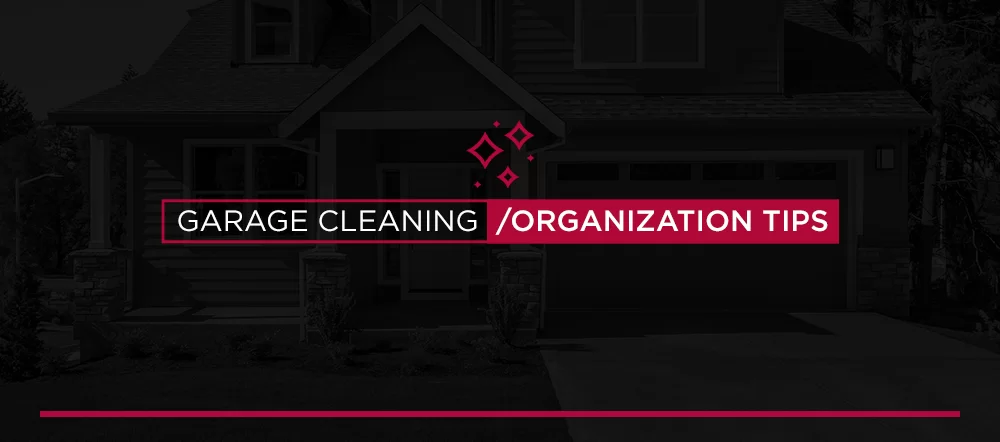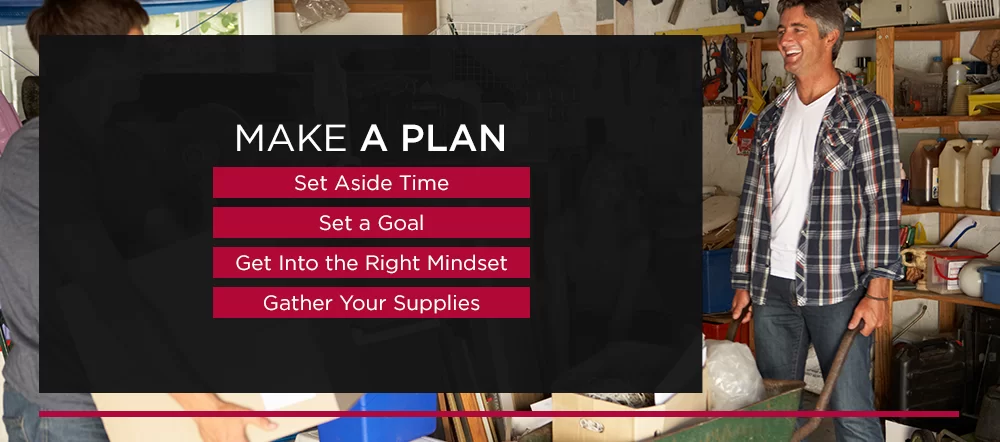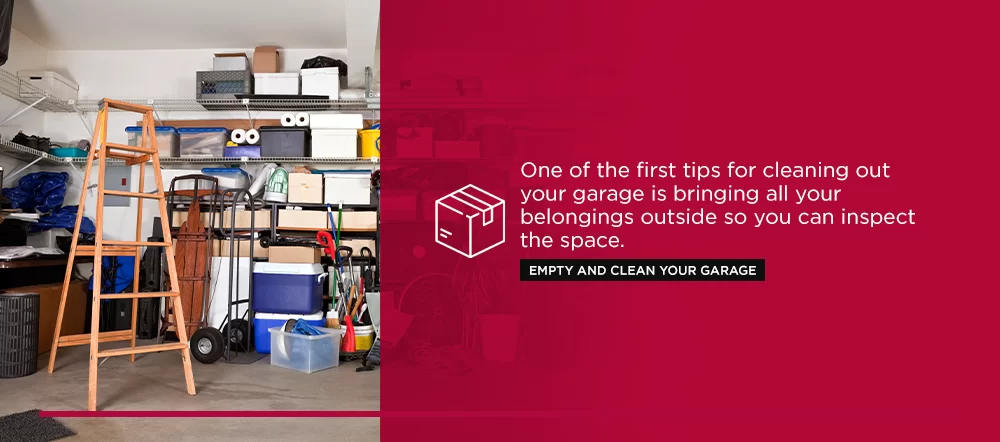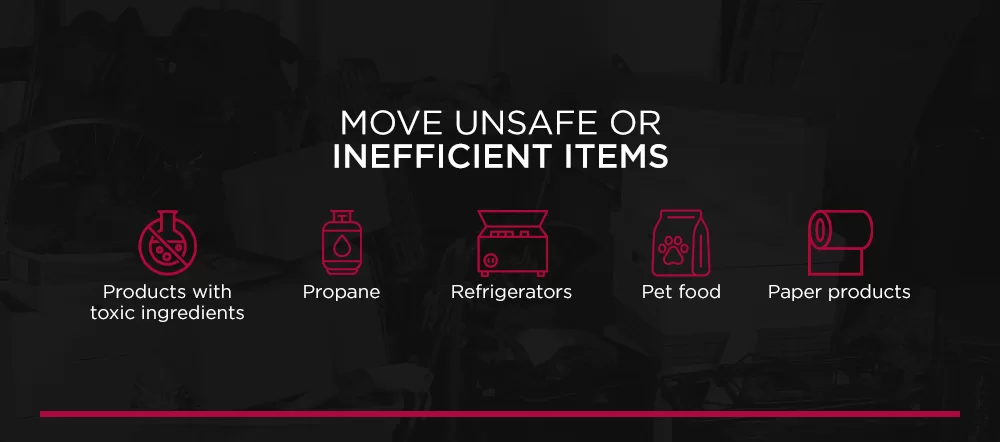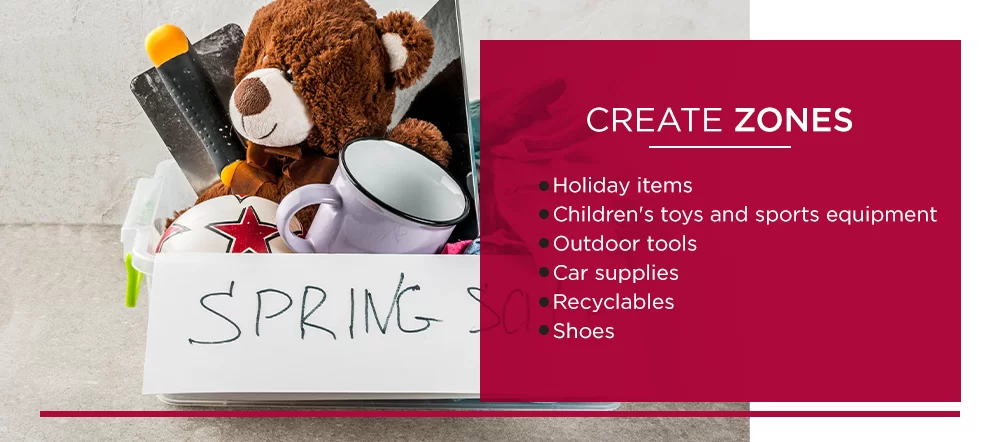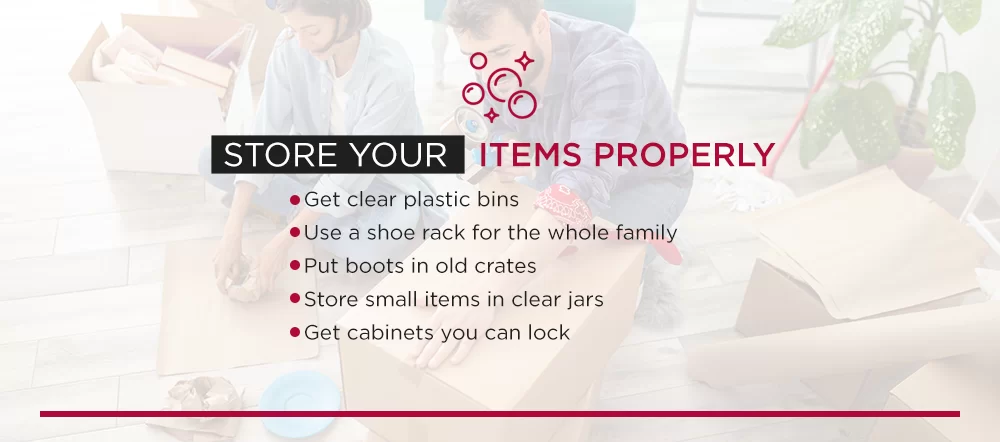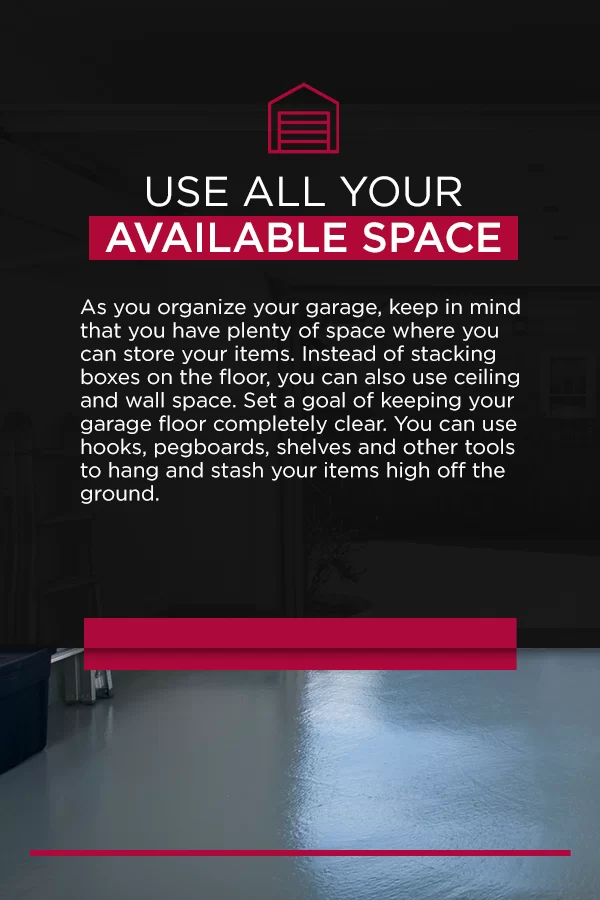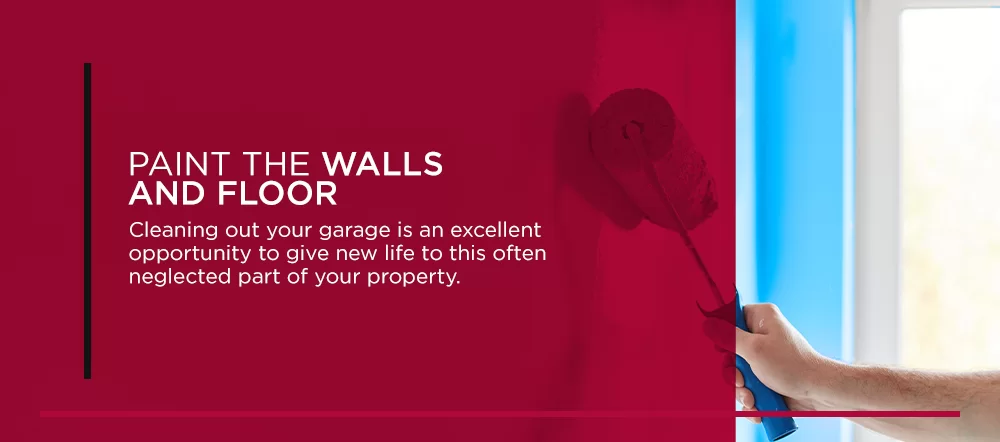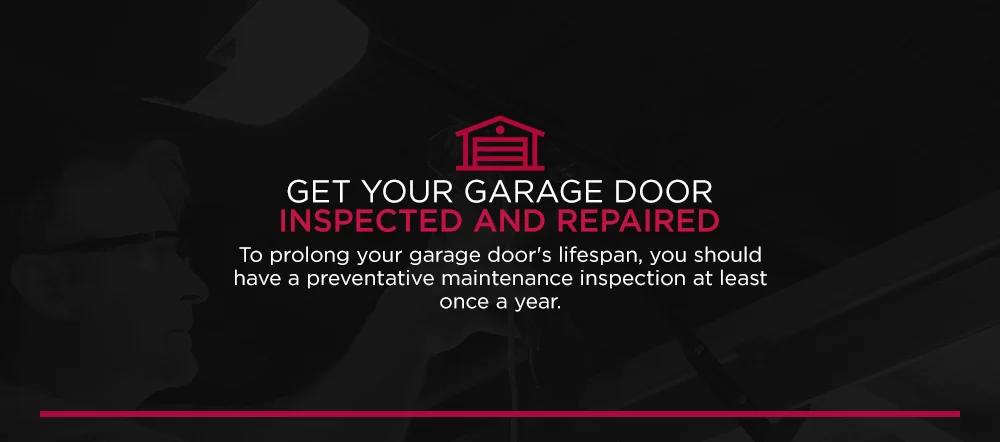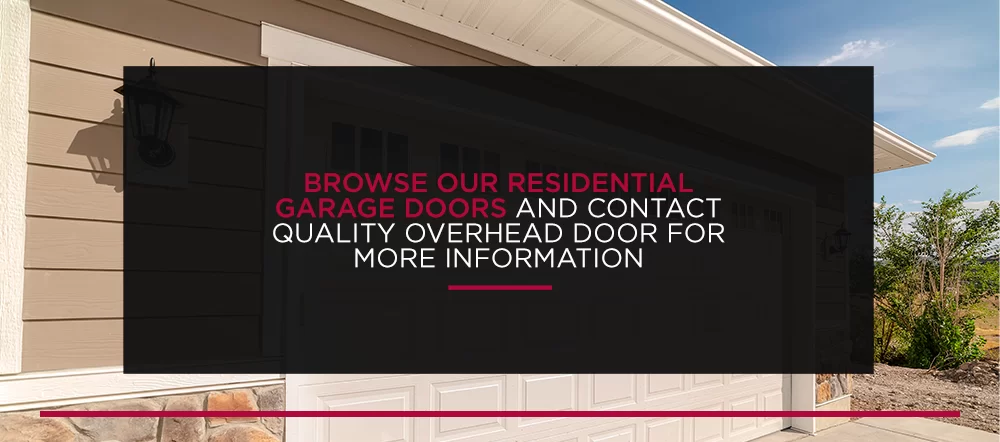It happens in almost every home: The garage becomes a dumping ground for everything that won’t fit in the house. That’s why garages tend to become a collection of stacked boxes, old furniture, appliances, toys, tools, yard equipment and more. In time, your garage becomes a mess, you park your car outside, and you wonder where it all went wrong. Organizing your garage can seem like an impossible task, but breaking it down into a few steps can help you succeed.
Here are some tips for organizing your garage to get your home back in order.
1. Make a Plan
Before you begin cleaning out your garage, you should create a plan to guide you throughout the process. Since you know your garage’s size, shape and purpose, you can make a map and decide where you want things to go. This outline may change and evolve as you work, but it will help you envision a clear, organized garage while you’re decluttering. Follow these garage organization tips to get started.
Set Aside Time
Serious garage decluttering takes at least a day — and sometimes it takes an entire weekend. If you only plan on cleaning for an hour or two, you may end up feeling discouraged if you take longer than expected. Make sure you dedicate enough time to organizing your garage that you can thoroughly accomplish the task.
As you create a garage cleaning schedule, be realistic about how much you can get done in your timeframe. If you’re going to get bored or tired halfway through the day, you can span your timeline across a few weekends to pace yourself. You could even ask your friends and family for help to save time and energy.
Set a Goal
Making time for garage organization usually involves more than marking it on the calendar. Try setting a clear, actionable goal to motivate you to keep cleaning out this part of your property. Maybe that goal is to start parking one or two cars in your garage or to sell enough used stuff that you make a certain amount of money. Set a clear plan to know what you’re exactly trying to accomplish and help you stay on task.
Get Into the Right Mindset
Effective garage cleaning happens when you are decisive and ruthless in your decision making. As you sort through your belongings and make an organization plan, remember why you started cleaning out your garage in the first place. Whether you wanted to park your car inside or provide another clear entryway into your home, you’re organizing this space for a reason.
Part of getting into the right mindset is taking care of yourself physically while you work. Pace yourself to prevent burnout and muscle strain. Take breaks often and drink plenty of water. If you start to feel bored, you can listen to music, podcasts or sports radio. Let your goal motivate you to keep moving forward.
Gather Your Supplies
Make a list of all the equipment you’ll need to organize your garage. Consider using some supplies — such as plastic bins for miscellaneous items, heavy-duty trash bags, a sturdy vacuum and a broom — to help you clean and organize your garage. You might also want to use gloves and other protective equipment when handling old trash and harsh chemicals.
2. Remove the Clutter
After you’ve come up with a plan, you can now clear out your garage. To give yourself space to work, park your cars in the street instead of the driveway. These cleaning out garage tips can help you sort through the clutter.
Empty and Clean Your Garage
One of the first tips for cleaning out your garage is bringing all your belongings outside so you can inspect the space. Instead of putting your belongings directly on the driveway, you can store them in plastic bins until you know what you want to do with them.
After emptying the garage, you can open any doors and windows to air out the old, musty smell. You can then sweep the garage and hose off the floor and walls to eliminate any stubborn debris. If you use a hose, remember to control water flow to prevent damage to your belongings. While your floor is drying, you can focus on going through the pile of clutter in your driveway.
Make Piles — Keep, Trash, Donate, Sell
Set up four containers and place items in piles marked keep, trash, donate and sell. As you sort through your belongings, think about how often you’ve used them in the last year or so. If you choose to donate some of your unwanted belongings, you can feel good about giving new life to things you haven’t used in a long time. If you decide to sell, you can have a yard sale at the end of your project and recoup money on goods you no longer need.
Since you’re not getting rid of everything, you need a keep pile for those belongings that you’ll put back in your garage. Some of your other things are beyond their usable lifespans, so you also need a trash pile. Heavy-duty trash bags make it easier for you to bring these unwanted items to the curb for pickup.
Move Unsafe or Inefficient Items
Besides getting rid of things you don’t want or need anymore, you should also try to make your garage a little safer. Keep in mind that there are some items you should avoid storing in the garage, such as:
- Products with toxic ingredients: If you store garden chemicals, paints or pesticides in your garage, consider moving them. You should only keep these poisonous products in approved containers that are fully closed and out of reach of children.
- Propane: Propane should ideally be in an open space, like a patio. Your garage is prone to swings in temperature — hot in the summer and cold in the winter. These changes can make propane more volatile.
- Refrigerators: You might want to have an additional refrigerator in the garage, but if this space isn’t insulated, the appliance will have to work harder in the summer, and you’ll most likely have to pay more on your energy bills. Consider putting it in the central part of your house instead of storing it in the garage.
- Pet food: Since the garage isn’t as insulated as the rest of the home, pet food can get stale more quickly. Rodents and bugs also snack on pet food, so if you keep it in your garage, you’re more likely to have a pest infestation.
- Paper products: Bugs and rodents also like to hide in cardboard boxes and piles of newspaper. Instead of leaving these items in the garage, you should bring them outside for recycling.
Tackle Your Hidden Messes
You may have items in boxes that you haven’t even unpacked yet. Instead of keeping or trashing the whole container, go through it and decide what to do with each item. You may find that two or three boxes can be combined into one when you try this method — ultimately saving you major space. As you go through all your bins, you might even find a family heirloom or other treasure that you want to keep or sell instead of throwing it in the trash.
3. Create Zones
Once you’ve gotten rid of all the clutter in your garage, you can start to reorganize your space. Think about how you’d like to use your garage, such as whether you only want to store your cars inside or make a small home office. When you figure out your garage’s purpose, you can sort your items based on how often you need to access them.
It helps to put belongings you tend to use together near one another. You can also put bulky equipment, such as your lawnmower, into a corner so you can avoid knocking into it with your car. Consider these best organization tips to store your belongings according to their use:
- Holiday items: Consider putting holiday items in clear plastic bins. Since you only need them during certain times of the year, you can store them on high shelves.
- Children’s toys and sports equipment: You can store your children’s toys in safe wire or mesh containers that they can easily access when they need them. Put the containers at a height your kids can reach so the bin doesn’t tip over when they’re trying to get their belongings.
- Outdoor tools: You should store your gardening and lawn equipment on vertical racks or PVC pipes screwed into the wall. Avoid storing sharp objects or other harmful equipment where young children can reach them. Try putting them close to the garage door so you can grab them before working outside.
- Car supplies: Consider storing your windshield wiper fluid, anti-freeze and car mechanical equipment in a place that’s easy for you to access but is out of reach of your children. Since they’re harmful chemicals, remember to keep them in airtight containers that won’t allow them to contaminate your property.
- Recyclables: You might want to put your recyclables close to the outside door, away from your property. If you don’t rinse off your recyclable items before putting them in bins, they might attract bugs and rodents into your home.
- Shoes: If you want to store your shoes in the garage, consider converting part of this space into a mudroom. Since your garage door allows you access into the home, your family could come inside, step on a welcome mat and hang up their coat on a rack.
Consider installing a fire extinguisher and a carbon monoxide detector for safety purposes, especially if you store your lawnmowing equipment in your garage. Gas could potentially start a fire, so it helps to have an extinguisher nearby if you’d ever need it. Since your car emits carbon monoxide as it runs, you might also want to have a carbon monoxide detector to give you peace of mind that you’re not breathing in toxic fumes as you park the vehicle.
4. Store Your Items Properly
As you plan to organize your garage, try to keep everything off the floor to prevent clutter buildup. Avoid using cardboard boxes that could attract pests and give them a place to hide. Since your frequently used items should be accessible to you, use storage units that help you get to your belongings more quickly.
If you don’t have a designated home for each of your valuables, follow these garage organization tips and tricks to organize your items with the following storage units:
- Get clear plastic bins: Even though bins come in various colors, consider getting clear plastic containers to help you see what’s inside. Stackable ones with lids can go against the wall or on a shelf.
- Use a shoe rack for the whole family: Instead of using an old crate, you can set up a shoe rack where everyone can keep their shoes.
- Put boots in old crates: You can store your large shoes in an open container so you can easily access them.
- Store small items in clear jars: These small, clear containers can store screws, nails or pens. Instead of buying new jars, you could save and wash old food containers.
- Get cabinets you can lock: You can organize your cabinets based on how often you need to access each item. Put small, frequently used items in drawers and things you don’t use in higher parts of the cabinet. Store the belongings that you don’t want children to touch in locked cabinets. You should get cabinets with raised legs so you can easily clean underneath them.
Besides getting the right storage units, you should also have a label maker on hand. You could either clearly label what’s inside your containers or set up a color code system so those outside your family don’t know what valuables you store in the garage.
5. Use All Your Available Space
As you organize your garage, keep in mind that you have plenty of space where you can store your items. Instead of stacking boxes on the floor, you can also use ceiling and wall space. Set a goal of keeping your garage floor completely clear. You can use hooks, pegboards, shelves and other tools to hang and stash your items high off the ground.
Simply clearing your garage floor will give the space a sense of decluttering. Consider the following ideas for garage organization tips to help you get creative with your storage.
Put It on the Wall
Use the vertical space in your garage by hanging items on the walls. Here are some ways to take advantage of this available area:
- Hang a bike rack on the walls: If you have room for it, you may want to install a bike rack in the garage. Bicycles can be bulky, but if you hang them on the wall, you can free up a lot of floor space.
- Install shelves on the walls: You can make your wall shelves as low or high as you want, as long as you can reach them. Open shelves are typically more affordable than cabinets, and they provide easier access for your belongings.
- Put a workbench on the walls: If you want to create a workshop in your garage, you can install a workbench that mounts onto the wall and folds down. Store your screws, nails and other equipment near the workbench to access these items when you need them.
Hang It From the Ceiling
Overhead shelves can usually hold large, bulky items, but you should look for storage products to accommodate the weight. You can put the things you don’t need to access often, such as holiday decorations and car maintenance equipment, near the ceiling to keep it out of the way. Like with your other types of storage, try to group like items together.
You might want to hang fishing poles and other long, flat items from your garage’s ceiling. Make sure you put them in a place where they won’t interfere with the garage door. Your belongings also shouldn’t scratch against the top of your car when you pull into the garage.
6. Update Your Garage
Once you have an organized garage, you might want to update its appearance and functionality. You should also do your best to keep it clean throughout the year to prevent the need to declutter it again soon. Follow these garage cleaning and organizing tips for maintaining this part of your property.
Paint the Walls and Floor
Cleaning out your garage is an excellent opportunity to give new life to this often neglected part of your property. After clearing out all the clutter from your garage, you might notice that the walls have chipped or faded paint. Before hanging up shelves or pegboards, consider refreshing the color with a new coat of paint first. You can also clean your garage floor by applying an epoxy coating to repair and prevent concrete cracks.
Update the Lighting and Electrical Systems
If the garage has gotten darker, inspect your light fixtures to find out if you need new bulbs. Your garage ceiling might have one lightbulb providing light to this part of your property, but you can install ambient lighting to make this area feel like the rest of the house. You might also be able to upgrade to a garage door opener with a light that turns on as you pull into the garage.
Besides your lighting, you might want to update the electricity, especially if you’re going to make your garage into a home office. Consider hiring an electrician to install ground-fault circuit interrupters (GFCIs) for outlets so you can have a safer, more reliable electrical connection.
Seal Air Leaks Throughout the Garage
Before installing your storage units, inspect the walls for gaps and seal them with silicone. If there are cracks in the walls that lead to a room in the central part of your house, they could leak air out of your home and raise your energy bills. You might also want to replace the weatherstripping around your garage door. As the largest opening in your home, it provides the most possibility for air leaks.
Get Your Garage Door Inspected and Repaired
To prolong your garage door’s lifespan, you should have a preventative maintenance inspection at least once a year. A qualified local technician can check your door for worn-out parts and repair them as necessary. If it’s particularly old, they might recommend getting it replaced. A newer, energy-efficient garage door tends to have a smooth, quiet operation, and it’ll be easier for you to get in and out of your garage.
If your garage door doesn’t need repairs or a replacement, you can clean it to restore its appearance. Apply mild detergent and water to the surface to get rid of stubborn debris, rinsing off the suds with a hose. You may also want to lubricate your garage door’s metal parts to make it work like new.
Browse Our Residential Garage Doors and Contact Quality Overhead Door for More Information
Your garage is an essential space in your home, and remembering these tips for cleaning out a garage could help you take care of it better. Besides cleaning out this part of your house, a brand-new garage door can help make the area more safe and comfortable.
At Quality Overhead Door, we offer residential garage doors in various materials, colors and sizes. If you don’t need a new one, we can also maintain and repair your current one. To request our services or get a free estimate, you can contact us online or call 419-578-8700 today.
Additional Resources on Garage Door Tips & Tricks:
- How to Clean Your Garage Door
- How to Properly Clean Exterior Doors
- How to Create Better Curb Appeal
- How to Battle Bugs in Your Backyard

